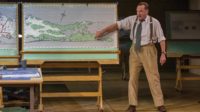|
Some years back the Chicago-based playwright and filmmaker June Finfer discovered stories about architecture to be packed with drama, and increasingly focused on this topic in her work. Her play, The Glass House, a quasi-fictional account of the story behind Ludwig Mies van der Rohe’s Farnsworth House, has been staged at various venues, including the terrace of the Farnsworth House. Most recently, the Resonance Ensemble company performed a short, sold-out run in New York City.
Finfer hopes the play will be presented at other theaters across the U.S.; in the meantime, she’s working on a new musical about Daniel Burnham. RECORD’s Suzanne Stephens recently spoke to Finfer about the making of The Glass House.
Suzanne Stephens: How did you become fascinated with architecture and Ludwig Mies van der Rohe?
June Finfer: My (late) husband had studied at IIT when Mies was there. So I heard a lot of stories about Mies and the group who came to Chicago from Germany just before the WWII. I was impressed that so much good architecture was being done because of Mies, his vision, idealism, and dedication. I began making documentaries on his work. The first was in the 1990s on Mies’s Lafayette Park housing [Detroit, 1956]. It focused on the work by Ludwig Hilberseimer, Mies, and the developer Herbert Greenwald. After that I made one on the Tugendhat House in [Brno, Czech Republic, 1930] and then the Farnsworth House [Plano Illinois, 1951]. The one on the Farnsworth was actually commissioned indirectly by its owner at the time, Peter Palumbo, and focused on origin of house, as well as his art collection.
SS: When did you start working on the play?
JF: Actually I started some time ago and, in the meantime, did a lot of research on Mies. And naturally I found Philip Johnson interesting as well. The relationship between Mies and Johnson was so complex. I thought he would be a good action figure in the play. You can’t just have people talking. Then I found that Lora Marx, Mies’s companion for over 30 years, started drinking a lot when he got the commission from Edith Farnsworth. So I decided to dramatize possible encounters between the two. Farnsworth and Mies had such a bitter separation, I thought there had to be more than to it than the design of the house.
SS: There are facts that are true in the play, and then a lot of things that aren’t verified—in the “could-be-true” category. What did you base your research upon?
JF: I read a lot, including Franz Schulze’s biography [Mies van der Rohe, a Critical Biography, 1985], and he gave me permission to use some dialogue. Also I read Edith Farnsworth’s unpublished memoirs. They were written many years after fact and were very bitter recollections. For example, she wrote in her memoirs, “He [Mies] never wanted a client, he wanted a dupe.” But a lot of the comments got cut from the final play. I never kept footnotes from my research—I’m not a scholar. So I am not sure what really happened in some cases. There is some invention—it is a play.
SS: You mentioned you worked a long time on the play—with various readings.
JF: I presented in readings at the Chicago Arts Club, The Chicago Art Institute, IIT, and even at the Farnsworth House, with a Chicago cast. As I heard it more and more, I cut it down and modified it.
SS: How did it come to New York City for the recent run?
JF: Kyle Bergman, the brother of the director Evan Bergman, is an architect and was planning a documentary film festival. I submitted my documentaries, which he liked, and I mentioned the play. He sent it to his brother, and they both wanted to option it. I have had other plays produced in Chicago, but this is my best so far. Once I started working with the Evan and the actors, they helped me see places that needed to be cut or changed. We did some readings around New York, including one at the Rose Room at Lincoln Center two years ago. The people from Philip Johnson’s Glass House in Connecticut even showed up.
SS: Why did you name your play about Mies and the Farnsworth House, “The Glass House,” when Philip Johnson’s house already was already called that?
JF: I didn’t know Johnson’s house was known as the Glass House. But of course the play is about both houses.
SS: Harris Yullin who played Mies, and David Bishins, who was Philip Johnson, were so good in their characterization. Did they do much research into the two architects?
JF: I had devoted a short section of the documentary on Lafayette Park to Mies, and gave to Yullin. Bishins didn’t do much research, but had been involved in the readings, and came up with his own take. By the way, two of Mies’s grandsons, one, the architect Dirk Lohan from Chicago, came to see the play and said Yullin really captured Mies’s mannerisms. The New York City run was a delightful experience, especially in seeing how the audience responded. The architects who came to see it really understood the play.
SS: What is your next play or documentary?
JF: My newest work is a musical called White City about the1893 World’s Fair in Chicago. I’m working with Elizabeth Doyle, a Chicago composer, and it will have a ragtime sound. I have a song “Never Marry an Architect” in it. The musical focuses on Daniel Burnham, John Root, Harriet Monroe, and Frederick Law Olmsted—and also goes into the origin of city planning. So far we’ve given a couple of concert performances in Chicago.





Post a comment to this article
Report Abusive Comment